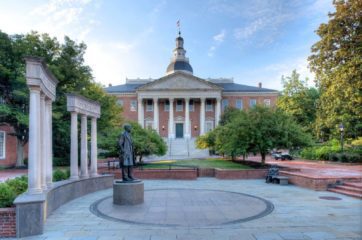Since 2017, carbon pricing has been on the mind of Maryland legislators and it has received national recognition as one of the most promising states when it comes to passing legislation. With over 3100 miles of shoreline, Maryland is also one of the most vulnerable states when it comes to climate change, making it all the more urgent that they take aggressive action to reduce their emissions and work to mitigate the impact that rising sea levels are projected to have on the state. With the carbon pricing movement rapidly gaining traction across the US and around the world, the new legislative session could present the perfect opportunity for Maryland to introduce a statewide carbon pricing model.
History of Maryland Carbon Pricing
In 2017, Climate XChange published a report detailing how a carbon pricing strategy could be implemented in the state, focusing specifically on how it could benefit the economy and support their lowest income communities. This report directly led to the creation of House Bill 939, also known as An Act Concerning Regional Carbon Cost Collection Initiative, which was proposed in the 2018 legislative session. The main sponsors for this Bill were Delegates David Fraser-Hidalgo and Ben Kramer, both members of both the Carbon Costs Coalition and the National Caucus of Environmental Legislators, have been champions of combating climate change during their time in office.
The bill they introduced proposed a fee on carbon emissions that would go into effect in 2019 and would start at $15/tonne, increasing by $5 annually until it reached a cap of $45/tonne. 90% of the revenue collected would go into a Greenhouse Gases Charges Fund and would be returned to Maryland residents and employers in the form of annual rebates. The remaining 10% would go into the Green Infrastructure Fund and would be invested in projects intending to improve transportation, resiliency, and other clean energy projects in the state. While this bill ultimately received an unfavorable vote by the Economic Matters Committee in March 2018, it gained the attention of many and Maryland legislators entered the 2019 session posed and more ready than ever to take action.
What’s Next?
Despite the 2018 setback in the House, Maryland is still considered a state with great potential for passing a carbon pricing. Jamie DeMarco, the state-level carbon pricing coordinator at Citizens Climate Lobby noted that Maryland, among several other states, is one to watch in 2019. This January, a new bill in Maryland, the Healthy Climate Initiative (HCI), was drafted and finalized, once again being sponsored by Delegates Fraser-Hidalgo and Kramer. This initiative proposes a $20/tonne fee on greenhouse gas emissions that will increase by $5 annually. There is no cap on the fee, but it will continue to increase by $5/year until the net emissions from fossil fuels are zero. The HCI would more closely resemble the proposed House Docket 2370 in Massachusetts, as 70% of revenue would be rebated to low and moderate-income families and vulnerable employers, and 30% being allocated to a Green Infrastructure Fund. From this portion, 40% would be used to invest in transportation, 25% would be used for clean energy and efficiency, 25% would be used in improving resiliency, and the remaining 10% would be used to facilitate the transition from fossil fuels to clean energy. According to the most recent projections, this could result in revenues of $3.5 billion in the Green Infrastructure Fund to be invested in these four sectors in the first five years.
Why Should Marylanders Care?
Maryland is one of the most vulnerable states when it comes to the effects of climate change. If temperature change and weather patterns continue, large portions of the state will be underwater by 2050. Increasingly severe weather events disrupt the economy and create millions of dollars worth of damage: The two Ellicott City floods this summer alone resulted in $50 million in repairs, with a projected additional $50 million in resiliency projects. Not only would the revenue collected from the HCI offset costs associated with extreme weather disasters such as these, but reducing emissions now would help mitigate the effects of climate change over several decades. The HCI would also help support the most vulnerable communities in Maryland. The majority of revenue levied would be used to offset the increased fuel prices for low and middle-income communities, as well as vulnerable employers, such as small nonprofits and those in the agricultural industry. The majority of low-income households will receive more in rebates than they will pay in charges. This proposed initiative will provide myriad benefits to the environment and to Maryland residents and it could make significant improvements in the economic and environmental health of the state.
There is reason for optimism and confidence in this Initiative succeeding this legislative session because the current political climate presents an opportunity that did not previously exist for gaining traction on environmental proposals. There is currently a Democratic supermajority in both the House and the Senate as well as a moderate Governor who has been considered a leader in climate action. Their state government appears more primed than ever to take action on a carbon pricing bill, not to mention an almost unanimous desire from Maryland residents to see their legislators take firm action on climate change. With support on the local and state level, 2019 could be the year that Maryland becomes a trailblazing state in climate action.









